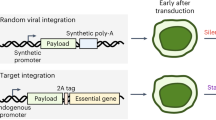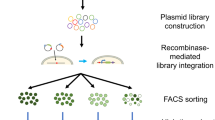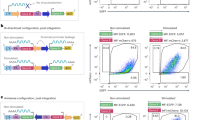Abstract
Attempts to generate reliable and versatile vectors for gene therapy and biomedical research that express multiple genes have met with limited success. Here we used Picornavirus 'self-cleaving' 2A peptides, or 2A-like sequences from other viruses1,2,3, to generate multicistronic retroviral vectors with efficient translation of four cistrons. Using the T-cell receptor:CD3 complex as a test system, we show that a single 2A peptide–linked retroviral vector can be used to generate all four CD3 proteins (CD3ε, γ, δ, ζ), and restore T-cell development and function in CD3-deficient mice. We also show complete 2A peptide–mediated 'cleavage' and stoichiometric production of two fluorescent proteins using a fluorescence resonance energy transfer–based system in multiple cell types including blood, thymus, spleen, bone marrow and early stem cell progenitors.
This is a preview of subscription content, access via your institution
Access options
Subscribe to this journal
Receive 12 print issues and online access
$209.00 per year
only $17.42 per issue
Buy this article
- Purchase on SpringerLink
- Instant access to full article PDF
Prices may be subject to local taxes which are calculated during checkout




Similar content being viewed by others
References
Ryan, M.D. & Flint, M. Virus-encoded proteinases of the picornavirus super-group. J. Gen. Virol. 78, 699–723 (1997).
Palmenberg, A.C. et al. Proteolytic processing of the cardioviral P2 region: primary 2A/2B cleavage in clone-derived precursors. Virology 190, 754–762 (1992).
Donnelly, M.L. et al. The 'cleavage' activities of foot-and-mouth disease virus 2A site-directed mutants and naturally occurring '2A-like' sequences. J. Gen. Virol. 82, 1027–1041 (2001).
Ryan, M.D., King, A.M. & Thomas, G.P. Cleavage of foot-and-mouth disease virus polyprotein is mediated by residues located within a 19 amino acid sequence. J. Gen. Virol. 72, 2727–2732 (1991).
Donnelly, M.L. et al. Analysis of the aphthovirus 2A/2B polyprotein 'cleavage' mechanism indicates not a proteolytic reaction, but a novel translational effect: a putative ribosomal 'skip'. J. Gen. Virol. 82, 1013–1025 (2001).
Klausner, R.D., Lippincott-Schwartz, J. & Bonifacino, J.S. The T cell antigen receptor: insights into organelle biology. Annu. Rev. Cell Biol. 6, 403–431 (1990).
Persons, D.A. et al. Use of the green fluorescent protein as a marker to identify and track genetically modified hematopoietic cells. Nat. Med. 4, 1201–1205 (1998).
Vanin, E.F. et al. Development of high-titer retroviral producer cell lines by using Cre- mediated recombination. J. Virol. 71, 7820–7826 (1997).
Julias, J.G., Hash, D. & Pathak, V.K. E- vectors: development of novel self-inactivating and self-activating retroviral vectors for safer gene therapy. J. Virol. 69, 6839–6846 (1995).
Liu, H.Y., Rhodes, M., Wiest, D.L. & Vignali, D.A.A. On the dynamics of TCR:CD3 complex cell surface expression and downmodulation. Immunity 13, 665–675 (2000).
Wang, B. et al. T lymphocyte development in the absence of CD3ε or CD3γδζε. J. Immunol. 162, 88–94 (1999).
Love, P.E. et al. T cell development in mice that lack the zeta chain of the T cell antigen receptor complex. Science 261, 918–921 (1993).
Chan, F.K. et al. Fluorescence resonance energy transfer analysis of cell surface receptor interactions and signaling using spectral variants of the green fluorescent protein. Cytometry 44, 361–368 (2001).
de Felipe, P., Martin, V., Cortes, M.L., Ryan, M. & Izquierdo, M. Use of the 2A sequence from foot-and-mouth disease virus in the generation of retroviral vectors for gene therapy. Gene Ther. 6, 198–208 (1999).
Klump, H. et al. Retroviral vector-mediated expression of HoxB4 in hematopoietic cells using a novel coexpression strategy. Gene Ther. 8, 811–817 (2001).
Emerman, M. & Temin, H.M. Genes with promoters in retrovirus vectors can be independently suppressed by an epigenetic mechanism. Cell 39, 449–467 (1984).
Wang, S., Beattie, G.M., Hayek, A. & Levine, F. Development of a VSV-G protein pseudotyped retroviral vector system expressing dominant oncogenes from a lacO-modified inducible LTR promoter. Gene 182, 145–150 (1996).
Borman, A.M., Le Mercier, P., Girard, M. & Kean, K.M. Comparison of picornaviral IRES-driven internal initiation of translation in cultured cells of different origins. Nucleic Acids Res. 25, 925–932 (1997).
Mizuguchi, H., Xu, Z., Ishii-Watabe, A., Uchida, E. & Hayakawa, T. IRES-dependent second gene expression is significantly lower than cap-dependent first gene expression in a bicistronic vector. Mol. Ther. 1, 376–382 (2000).
Sorrentino, B.P. Gene therapy to protect haematopoietic cells from cytotoxic cancer drugs. Nat. Rev. Cancer 2, 431–441 (2002).
Pizzato, M. et al. Production and characterization of a bicistronic Moloney-based retroviral vector expressing human interleukin 2 and herpes simplex virus thymidine kinase for gene therapy of cancer. Gene Ther. 5, 1003–1007 (1998).
Moriuchi, S. et al. Enhanced tumor cell killing in the presence of ganciclovir by herpes simplex virus type 1 vector-directed coexpression of human tumor necrosis factor-alpha and herpes simplex virus thymidine kinase. Cancer Res. 58, 5731–5737 (1998).
Kessels, H.W., Wolkers, M.C., van, D.B., van der Valk, M.A. & Schumacher, T.N. Immunotherapy through TCR gene transfer. Nat. Immunol. 2, 957–961 (2001).
Zitvogel, L. et al. Construction and characterization of retroviral vectors expressing biologically active human interleukin-12. Hum. Gene Ther. 5, 1493–1506 (1994).
Vignali, D.A.A. & Vignali, K.M. Profound enhancement of T cell activation mediated by the interaction between the T cell receptor and the D3 domain of CD4. J. Immunol. 162, 1431–1439 (1999).
Markowitz, D., Goff, S. & Bank, A. A safe packaging line for gene transfer: separating viral genes on two different plasmids. J. Virol. 62, 1120–1124 (1988).
Persons, D.A. et al. Retroviral-mediated transfer of the green fluorescent protein gene into murine hematopoietic cells facilitates scoring and selection of transduced progenitors in vitro and identification of genetically modified cells in vivo. Blood 90, 1777–1786 (1997).
Persons, D.A., Mehaffey, M.G., Kaleko, M., Nienhuis, A.W. & Vanin, E.F. An improved method for generating retroviral producer clones for vectors lacking a selectable marker gene. Blood Cells Mol. Dis. 24, 167–182 (1998).
Carson, R.T., Vignali, K.M., Woodland, D.L. & Vignali, D.A. T cell receptor recognition of MHC class II-bound peptide flanking residues enhances immunogenicity and results in altered TCR V region usage. Immunity 7, 387–399 (1997).
Acknowledgements
We are very grateful to Cox Terhorst and David Baltimore for reagents and Terry Geiger for his critical review of the manuscript. We also wish to thank Richard Cross, Jennifer Hoffrage, Richard Ashmun and Ann-Marie Hamilton-Easton for assistance with flow cytometry, staff in the Hartwell Center for oligo synthesis and DNA sequencing, and members of the Vignali lab for constructive criticism, comments and bone marrow isolation. This work was supported by grants from the National Institutes of Health (AI39480, AI52199), a Cancer Center Support CORE grant (CA-21765) and the American Lebanese Syrian Associated Charities to D.A.A.V.
Author information
Authors and Affiliations
Corresponding author
Ethics declarations
Competing interests
The authors declare no competing financial interests.
Rights and permissions
About this article
Cite this article
Szymczak, A., Workman, C., Wang, Y. et al. Correction of multi-gene deficiency in vivo using a single 'self-cleaving' 2A peptide–based retroviral vector. Nat Biotechnol 22, 589–594 (2004). https://doi.org/10.1038/nbt957
Received:
Accepted:
Published:
Issue Date:
DOI: https://doi.org/10.1038/nbt957
This article is cited by
-
De novo identification of CD4+ T cell epitopes
Nature Methods (2024)
-
Effect of hormone-induced plasma membrane phosphatidylinositol 4,5-bisphosphate depletion on receptor endocytosis suggests the importance of local regulation in phosphoinositide signaling
Scientific Reports (2024)
-
StayGold variants for molecular fusion and membrane-targeting applications
Nature Methods (2024)
-
Widefield imaging of rapid pan-cortical voltage dynamics with an indicator evolved for one-photon microscopy
Nature Communications (2023)
-
Generation of bicistronic Dmp1-Cre knock-in mice using a self-cleaving 2A peptide
Journal of Bone and Mineral Metabolism (2023)



